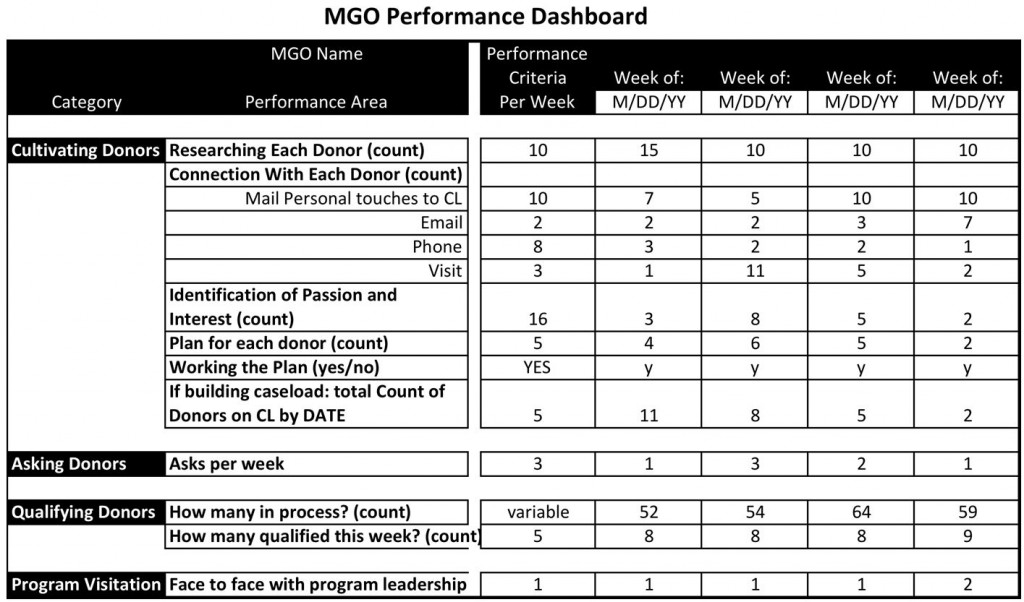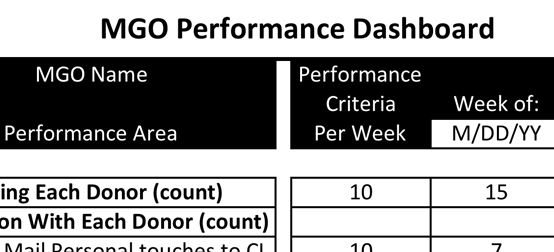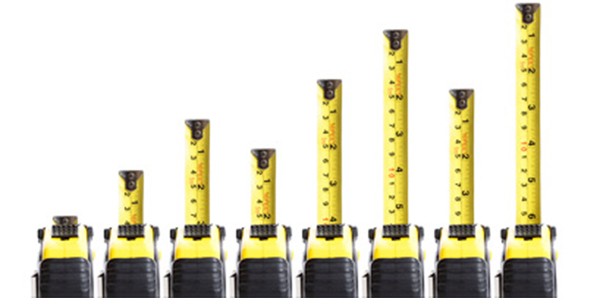It is amazing to Jeff and me how often MGOs are left to wander in their jobs with no guidance and no measurement of performance. That’s why we came up with the following MGO Performance Dashboard:

If you are an MGO reading this, don’t get wound up. This is not intended to make your life miserable. On the contrary, if you have a manager that does not manage you – and believe me, there are thousands of MGOs in this predicament – then you should use this dashboard, or some form of it, to manage yourself.
Here’s why.
It is so easy for MGOs to become distracted in their work. And it happens more often than not. Sometimes MGOs are blamed for the distraction when, in fact, it is the manager above them who is pulling them in every direction away from their caseload.
Jeff and I are aware of several situations where the MGO is not only charged with managing 200 donors on a caseload (too many, by the way) but also may have promotion and marketing responsibility for an assigned geography. This is absolutely insane, but the manager, who came up with the idea, claims it really works and provides the needed PR and events coverage of every inch of real estate of the non-profit’s footprint.
Never mind that when you look at the caseload performance of the MGOs in this system, the value attrition (giving from the same donors year to year) is so high that millions of dollars are slipping right out the door. Does this manager care about this? Apparently not, because he is so in love with his system that he can’t see the dollar value lost.
But, I digress.
We were talking about focus and staying on point. That is what this dashboard does. It helps the self-managed MGO or the manager of the MGO keep things on point in four critical areas:
- Cultivating Donors – This section sets weekly criteria for researching and connecting with donors. Remember, a connection can be via email (or letter), phone or visit. Some managers are obsessed with how many visits an MGO makes. Well, what if the donor prefers to talk via email or the phone? Doesn’t that count? Of course it does. This section also tracks the work you are doing to identify the passion and interests of the donor, the planning you are doing for the donor, and whether you are working the plan.
- Asking Donor – It is always amazing to Jeff and me how many MGOs get so busy doing the work that they forget to manage the volume of asks they are making. I know it’s obvious, but if you aren’t proactively managing the number of asks you are doing each week you will get behind.
- Qualifying Donors – If you are a new MGO and are building a caseload, this section tracks your progress. Qualifying donors takes a long time. We suggest no less than 5 per week.
- Staying Connected to Program – And this is the final and critical piece that is often forgotten by MGOs – staying in touch with program. You need to do this at least once per week, maybe more. Why? So you know what is going on in program and, even more importantly, so your heart and head are personally connected to the cause you are presenting to donors. Too many MGOs do not stay connected to program in a meaningful way. And that is why their presentations to donors lack authenticity, emotion and passion. Stay connected.
As you look to incorporate this dashboard into your system don’t get hung up on the numbers we have suggested. Make up your own. The important point is to be in control of what you are doing each week in each of these four areas.
Richard







Jeff, I read your posts regularly and with great interest. One of the things that keeps popping up for me is that the information you provide is focused on mature major gift programs, one in which an MGO has 150 actual donors on the file. Do you provide any information geared toward major gift programs that have, say, 2 or 3 officers who have caseloads of 50-70 donors, and the rest of the caseload is prospects? I would love to learn more about the ins and outs of evolving and managing that sort of program.
Hey Chris. Thanks for your question. Actually, everything we talk about here in this blog is applicable to any type of caseload size. Veritus works with all types of organizations with various sized caseloads. 150 is just the maximum size.
Jeff
I am a MGO in a medium size NPO. This is a first-time position for this organization. I am tasked with researching donors and building my own caseload and am always looking for ways to help organize donors and measure my own performance. I’ve been in this position for 2 months and sometimes, I’m overwhelmed, not only by the amount of donors we have on record, but also by the potential. This helps break it down for me. Thank you so much for posting this.
Your welcome, Candi. Remember, when looking at the amount of donors, that they do fall into a hierarchy of value that is relatively easy to identify. It’s the confluence of current giving (inclination) and capacity that should be your measure and priority.
Dear Jeff,
dear Richard,
this dashboard is awesome! A piece of beauty. Thanks a lot!!!
Can you share this dashboard in a excel file? I really love your site and the treasure trove of information you provide.
Hey commentary . I learned a lot from the information , Does someone know if my company might be able to find a template a form copy to fill out ?